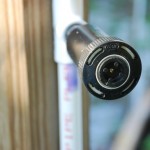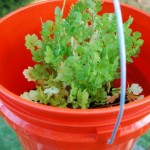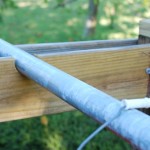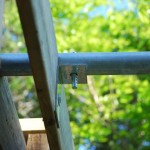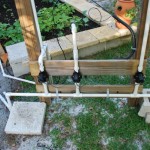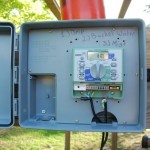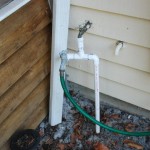I thought that growing your own vegetables might be a fun way to get fresh veggies. Come to find out though, these damn gardens are a lot of work! I was all like, “Oh hell no, no you didn’t.”, and such. Later I calmed down and decided to automate the watering process. Here’s how it went down.
The garden consists of two main components, the ground garden and the hanging plants. The ground based garden has rows of plants and two potted plants on opposing corners, while the hanging garden consists of four tomato plants hanging upside down in buckets.
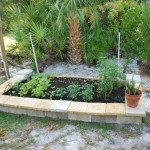
Those heavy tiles on top of the cinder blocks aren't glued, they'll break your ankles if you step on them wrong, probably. That's a design feature to keep out rabbits.
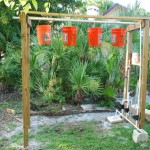
My hanging garden. I'm also contractually obligated to say that home depot made this possible (not really)
The lower garden is watered in two ways, a drip line that runs along the plant rows and into the two potted plants and two misters/sprayers that drizzle water down on the entire garden.
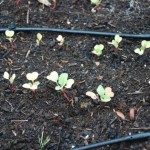
I laid the drip lines using the proximity to the plants to indicate the most popular sprouts, obvious favoritism.
The hanging garden is also watered in two ways. A line of sprayers along the top waters the inside of the buckets, which also happen to have herbs in them, like cilantro, basil, mint and chives and a set of misters that briefly, a couple times a day, spray down the leaves and stems of the hanging tomatoes since it’s late in the season in florida and they’d probably fry otherwise.
The buckets are hanging on a steel electrical conduit. I cut semi-circles in boards on either side for it to rest in and used a locking pin mechanism to keep it in place.
A set of three valves controls water flow to the three different watering mechanisms; drip lines, misters and bucket sprayers. It’s currently controlled by a cheap, standard 4-zone sprinkler timer.
The entire system enjoys a permanent connection to water and power. The water connection is a Y junction that allows for a standard garden hose to be used, still. The power is an outdoor outlet cover containing a wall-wart power supply. Both go through underground pvc pipes that lead to the garden.
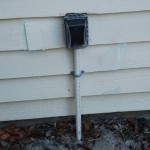
I only ran a small bit of current through the ground, enough to power the valves and timer. What if a mole chewed through a high voltage line? Save the moles.
Ok, wrap up time. The wires are a bit messy, I plan to do a little more wire management before I call it finished. Additionally, I’d like to make my own timing mechanism using an arduino instead of the standard timer, for a couple reasons. I’d like to put some sensors up and measure some things, like soil moisture, temperature, light and then water the plants accordingly. Also, it’d be neat to control the garden from a web interface. Finally, I thought that the addition of a motion sensor that set off the misting sprinklers might be a nice, humane pest control.
Back flow description on wikipedia
QJX8BYMNWEYV
π


